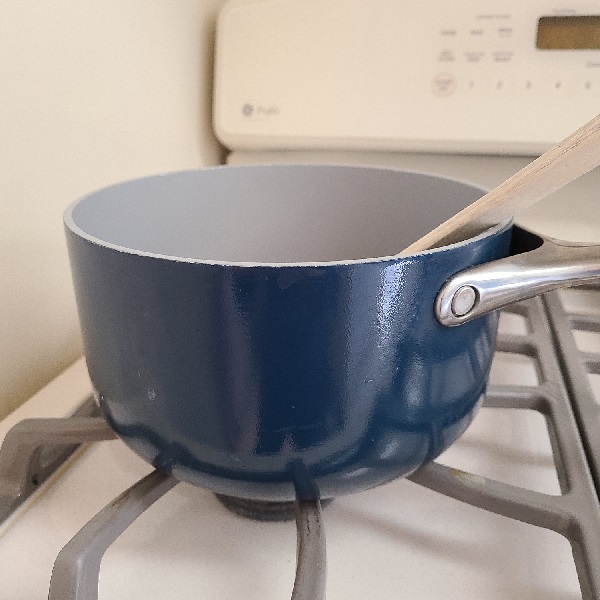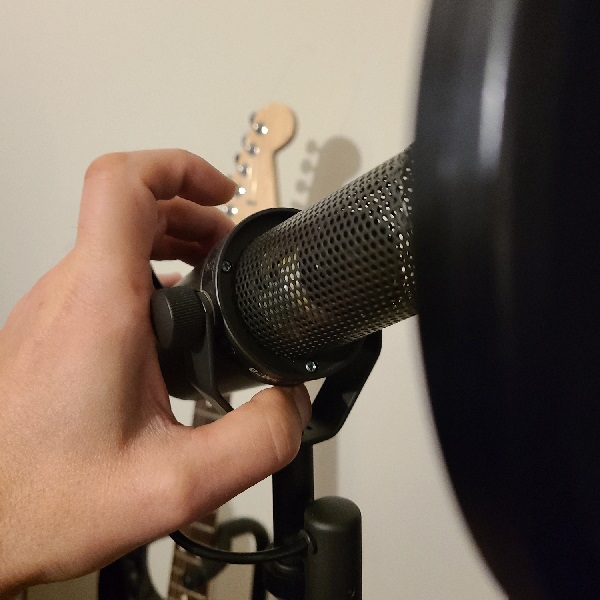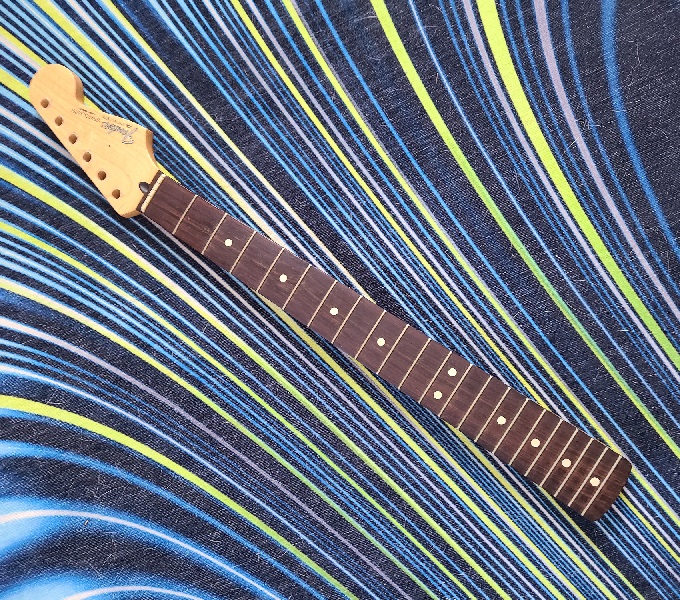I am just about finished with a 12-song set. It took a couple of months. Others go through songs quickly – a 3-4 hours per song. Not me. I spend a couple of days per song. Why? It just takes that long. Check this out.
A simple song to mix
Say I get the stems for a simple song: drums (kick, snare, high hats, cymbals, toms; to make things easy, all toms are together, and all cymbals are on one track too), bass, three guitars (rhythm, some riffs, solo), two vocals (main and harmony). All in all, this is 11 tracks.
I also ask for the song tempo (e.g., 100 beats per minute or 600 milliseconds per quarter note) and a reference song.
I start mixing.
Mixing

Evaluate for pops, clicks, noise, other oddities
Some things are easier to hear if you listen to individual tracks.
- Pops and clicks are rare, but I have seen tracks (bass and guitar) where someone used the DAW aggressively to chop up takes and align notes to the drums, getting truly audible pops. There is also the vocalist thumping with legs next to the microphone or, let's hope not, otherwise fiddling with the microphone. There is the random fiddling of the guitarist before the guitar solo starts.
- Noise happens often on the vocals and sometimes on guitars and bass too (e.g., a hum).
- Other things can be heard either in the overall mix or on individual tracks. An example is a bass heavy, ringing kick.
- Some people look for DC offset (I don't).
- Some vocals will need tuning. It was noticeable in 3-4 of the 12 songs, but let's forget about this. That itself could take a ridiculous amount of time.
Don't fiddle with the microphone

I also listen to each track against the drums to check how they align. This is important if the rhythmic arrangement is complex. You could hear that the song is dragging, as if musicians are slowing down. In the mix, however, you wouldn't know where the drag comes from.
Put some effort into separating tracks
I call this the initial mix. I attempt some panning and some adjustments in the frequency spectrum, some volume adjustments. In short, I do some usual things without much thought just to hear the tracks in the overall mix and understand the song.
- I try a gentle pan of the snare and high hat to get the song pulsating between left and right. I may push the cymbals and toms slightly further, partly so they don't mix with the high hats and kick respectively, but also to get some movement that forces the listener to pay attention. Once I got a song that had a single tom hit – right in the middle. But it was there. I had to work with it.
- The bass often gets a high pass filter to get rid of low-end boom. The bass may also get a mid EQ adjustment, but that is rare.
- Guitars get panned, high passed (but almost never EQ-ed at this point).
- Vocals get a gentle compression.
All tracks will get some volume adjustments. There is nothing special here, but:
- I like an audible bass.
- I also like an audible kick.
- I don't like overwhelming high hats, solos.
- Rhythm and riffs should fit together.
- Main vocals and harmonies should fit together.
- Vocals need to sit in the mix.
And so on.
This is a good start. Here is some more.
- On rare occasion, I make minor adjustments to song arrangements by, say, dropping bits and pieces of guitars (it could literally be a note). This is probably not the engineer's job, but it is worth a try.
- On even rarer occasions, I align bass and guitar parts to the rhythm. If it makes a better song, why not?
- Vocal compression is an art. I experiment with standard compression at different thresholds, a sequence of parallels, or something in between. I want to preserve as much of the original vocal quality as possible, but make sure the vocal does not come in and out in a distracting way.
It is OK to drop pieces of guitars

Listen
I leave time to listen to the song.
- Listen at low volumes to make sure all tracks are heard as appropriate.
- Listen at higher volumes to make sure there is no fatigue.
The art of mixing starts here
Now I have a song, but it is not yet the best song it can be. Also, it does not represent what others want (i.e., you have a reference track after all).
A thousand things can happen here. Here are some of the usual things with this last set of songs.
- Snare compression and, rarely, snare replacement: I like a snare that sounds like a real snare, but the snare ring could be too much.
- Snare, high hat, cymbal EQ: These might need to be brighter. The reference track helps.
- The kick may also need adjustments. It is a bit easier than the snare though. Sometimes, a high pass filter will do just as well on a ringing kick as a compressor.
- Bass compression, bass EQ: Bass compression is tough, because it doesn't work as well with contemporary plugins. The piece of digital compressors that is supposed to detect amplitude is not ideal and acts like a band pass filter. It doesn't work very well at low (or high) frequencies. I use bass compression very rarely and very gently. Bass EQ is also tough and, frankly, should have been handled during recording. I have been known to just get a new track.
- Guitars take a lot of experimentation. Delays are always interesting and conceptually simple, but they are not one-size-fits-all. Even on a simple delay, I experiment with the amount of decay and I adjust the delay to the tempo. But the delay doesn't have to be simple. It could end up on the other side of the panning spectrum, which requires its own decay, delay, volume, and pan adjustments. The choice of cutoff for guitar high pass filters, unlike that for bass ones, can have a quite a range. Finally, some guitars, especially acoustic solos, may get compression.
- I don't play with vocals much at this point, but I do adjust volume and compression based on the resulting mix.
Then, there is reverb.
- My main question is: Which tracks would be bounced together for an overall reverb and which ones will get their own? Snares, high hats, cymbals often get their own, if only to avoid any pre-reverb delay. Guitars often get bounced together, but not always (e.g., often not the solo). The vocals may go with the guitars, but that depends on the vocals and guitars.
- A lot of experimentation also goes with the amount of predelay and total reverb length, partly to match the tempo and partly to make sure there are no wide, distracting discrepancies between tracks.
- There is always the issue of any interaction between guitar delays and guitar reverbs.
In all of this, the reference track is important so that I don't lose track of where this is all going.
Listen
I have been listening to the song over and over anyway, but it pays to listen as a listener, throughout, by itself or in comparison to the reference track.
- Listen at low volumes to make sure all tracks are heard as appropriate. I may notice that I have lost the rhythm guitar, that the bass has taken a back seat, or that the vocals are too prominent or not prominent enough.
- Listen at higher volumes to make sure there is no fatigue. I may discover that the high hats are repetitive or the vocals are too harsh.
- Listen at whatever level (usually mid for me) to get an idea of right-left balance. Listen also to other songs to get an idea of overall volume levels.
Listen

The art of mixing continues
If all is well, adjustments should be minor.
- Some tracks will move up and down by a dB or two.
- Slight adjustments to panning are to be expected.
- Vocals (and on very rare occasions, solos) may get a multiband compressor or another EQ.
- Tiny overall eq adjustments can have profound effects. It is extremely rare that I would attempt those, but they are available.
- Overall limiters are available too, but not absolutely necessary.
Don't forget the excitement
We are not done yet. I don't really think it is always the job of the engineer to deal with these, but you have phasers, flangers, choruses, echoes, aural exciters, wah wah, vibratos, tremolos, etc. etc.
- A tiny riff in one of the 12 songs got an echo that bounced between the left and right channel. It was just better than the original delay.
- An acoustic guitar in one sparse song got a slight and slow wah wah. The guitar now demands attention.
- One vocal got a bit of high frequency distortion to make it more exciting. I am still waiting on the musicians' opinions on that one.
Nothing else happened, but I did experiment with some choruses and flangers.
Side chained compressors and ducking are not typical for the style I play with but could be warranted. I didn't mention it above, as it is not usual for me. Some time ago I worked with an acoustic guitar instrumental, for which the author specifically requested a huge amount of reverb. In this case, ducking helps reduce reverb muddiness.
Don't forget dynamics
It is different for different folks, but I find it easier to think of song dynamics only when I can get a very clear idea of the overall song. Unfortunately, this means repeating some of the tasks above.
And there is the song
If I was working on my own songs, this is where I might just decide to shelve a song and forget about it. It happens.
More importantly though, this is quite an effort. I can't imagine knocking out a song in half a day. It is more of a two-day effort for me. It also explains why this is not my main profession and do this mostly for fun. I would have to charge $1000 a song or more to make this worth my time.
Don't let perfect be the enemy of good
Don't get me wrong. Yesterday, I received a drum track and a few guitar tracks, tracked the vocals and bass, fixed up the gain and panning, added some delays and reverbs, vocal compression, and so on. I even put a bit of distortion on some guitars and aligned the bass. This only took about 30 minutes and made a song that was pleasant to listen to. Is it good? Yes. Will I release it? No. It could be better, but it will take some time to get there.
authors: mic
Add new comment